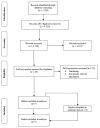Sex/Gender Differences in the Association between Residential Green Space and Self-Rated Health-A Sex/Gender-Focused Systematic Review
- PMID: 31801219
- PMCID: PMC6926795
- DOI: 10.3390/ijerph16234818
Sex/Gender Differences in the Association between Residential Green Space and Self-Rated Health-A Sex/Gender-Focused Systematic Review
Abstract
Though sex/gender is an important social determinant of health, sex/gender inequalities have not been considered comprehensively in environmental health research thus far. The aim of this systematic review was to clarify whether sex/gender theoretical concepts were addressed in studies on the impact of residential green space on self-rated health and whether effect modification by sex/gender was observed. Three electronic databases were searched to identify epidemiological studies on perceived or objective residential green/blue space and self-rated health. Necessary for study inclusion was mentioning at least one keyword for sex/gender in title or abstract, adult study participants and data on self-rated health and on availability and/or use of green/blue spaces. Decisive for study inclusion was consideration of sex/gender differences in the impact of perceived or objective residential green/blue spaces on self-rated health in the analysis and presentation of results. Seven studies were included. They presented an overall positive impact of green space on self-rated health. No consistent sex/gender differences in the impact of green space on self-rated health were found in these studies. However, all studies used a binary operationalization male/female without further theoretical foundation. Research quality could be enhanced by integrating sex/gender-theoretical concepts into study design and interpretation of results.
Keywords: blue space; environment; gender; green space; greenness; nature; park; self-rated health; sex.
Conflict of interest statement
The authors declare no conflict of interest. The funders had no role in the design of the study; in the collection, analyses or interpretation of data; in the writing of the manuscript, and in the decision to publish the results.
Figures
References
-
- Hammarström A., Johansson K., Annandale E., Ahlgren C., Alex L., Christianson M., Elwer S., Eriksson C., Fjellman-Wiklund A., Gilenstam K., et al. Central gender theoretical concepts in health research: The state of the art. J. Epidemiol. Community Health. 2014;68:185–190. doi: 10.1136/jech-2013-202572. - DOI - PubMed
-
- Bolte G., David M., Debiak M., Fiedel L., Hornberg C., Kolossa-Gehring M., Kraus U., Latzsch R., Paeck T., Palm K., et al. Integration of sex/gender into environmental health research. Results of the interdisciplinary research network sex/gender-environment-health (GeUmGe-NET) Bundesgesundheitsblatt. 2018;61:737–746. doi: 10.1007/s00103-018-2745-8. (In German) - DOI - PubMed
Publication types
MeSH terms
LinkOut - more resources
Full Text Sources


